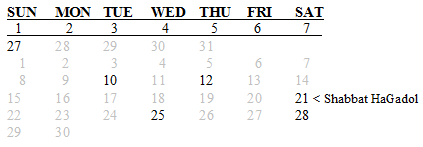Messiah’s Crucifixion in April 31 AD
From the Book Reckoning of Time
According to US Navy Observatory (USNO) the Vernal Equinox in 31 AD fell on Friday, March 23, at 3 a.m. Greenwich Time (see Appendix H). The full moon after the date of the equinox was Tuesday, March 27 at 11 a.m. and the New Moon fell on Tuesday, April 10, at noon Greenwich Time. Note that the USNO New Moon and the Biblical New Moon differ in three days. The secular science calls New Moon when the Moon is dark and invisible. In the first two days after New Moon, the young crescent Moon appears very low in the western sky after sunset and sets shortly after sunset. The sighting of the lunar crescent within one day of New Moon is usually difficult.
The Biblical New Moon is when the first sliver of the Moon is sighted within a couple of days after the secular one. Therefore, on Thursday, April 12, 31 AD the first month of the new Biblical Year (Rosh HaShanah) began given the barley was Aviv (Exo_12:2). Shabbat HaGadol (The Great Sabbath) was on Saturday, April 21, and according to Lev_23:5 in the first month, on the fourteenth day of the month, between the evenings, was the Passover, which leads us to WEDNESDAY, April 25, 31 AD, Full Moon, (Passover is always on Full Moon) as the day of the crucifixion of Yeshua and SATURDAY, April 28, 31 AD the day of His resurrection. And below is the chart of the events for 31 AD.

There are no recorded astronomical events that can prove or disprove 31 AD as the year of crucifixion, but this does not mean that this hypothesis can be easily ruled out. On the contrary, it will be kept into consideration and not dismissed because it satisfies the basic requirements for being a potential year of the crucifixion, namely the fourth day was Passover and therefore the day of death of Yeshua and the seventh day, Sabbath, as the day of the resurrection. But, which year 28 AD or 31 AD is the true year in which Yeshua was crucified?
There is one more way to determine Messiah’s crucifixion. The Gospel according to Yochanan says it took forty-six years to build the Temple,
Then the Yehudim said, “It took forty-six years to build this Dwelling Place, and You are going to raise it in three days?” (Joh 2:20)
Per Flavius Josephus (Antiquities of the Jews Book 15:11:1), the reconstruction of the Second Temple built by Zerubavel commenced in the eighteenth year of King Herod’s reign:
And now Herod, in the eighteenth year of his reign, and after the acts already mentioned, undertook a very great work, that is, to build of himself the temple of God,
Herod’s rule in Judea (37 BC–1 BC) was contemporaneous with the rule of the Roman Emperor Augustus (63 BC–14 AD). The eighteenth year of Herod and therefore, the reconstruction of the Temple began in 19 BC. There are 360 days in a biblical year: 360 x 46=16,560 days and there are 365.2422 days in a solar year. If we divide 365.2422 days into 16,560 days, we get 45 years and 135 days, or 46 years. In reckoning years from BC to AD, one year must always be omitted, because there is no 0 year. The Julian calendar does not include the year 0, so the year 1 BC is followed by the year 1 AD. Subtract 45 years and 135 days from 19 BC and we arrive at 28 AD, or the calculation is to be: -19 + 46 + 1 = 28 AD.
Therefore, 28 AD is the correct year of crucifixion and resurrection of the Messiah.
